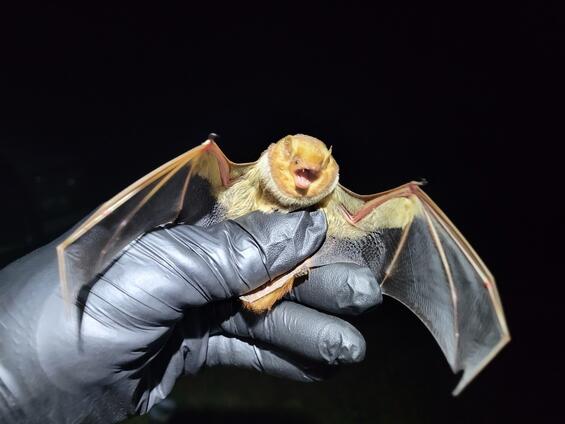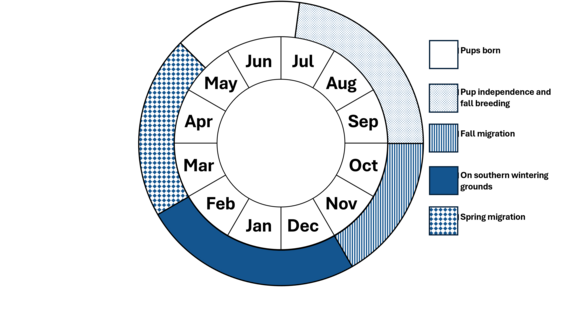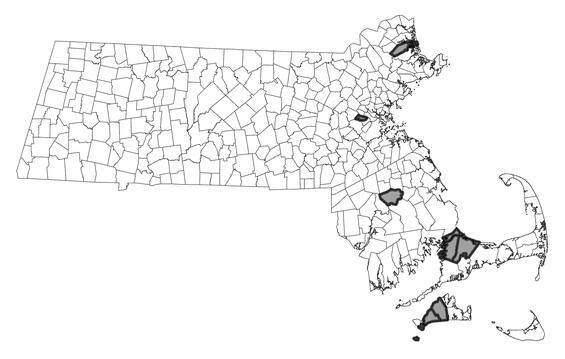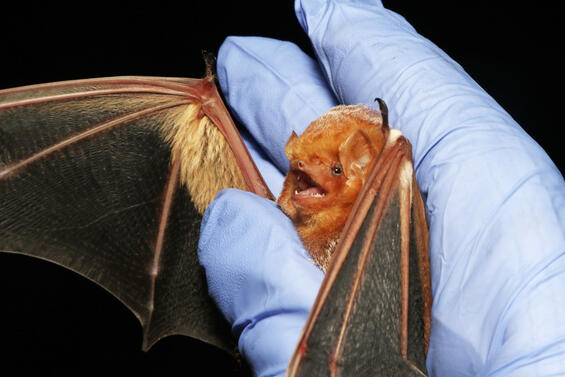- Scientific name: Lasiurus borealis
- Species of Greatest Conservation Need (MA State Wildlife Action Plan)
- Special Concern (MA Endangered Species Act)
Description

Eastern red bat (Lasiurus borealis)
Eastern red bats have reddish or rusty-colored fur, with white-tipped hairs on their backs and breasts. This is our only species of bat which exhibits sexual dimorphism in the fur color. Males have a bright brick red fur, while females have duller, buffy-chestnut fur, with much more white tipping of the fur. The total length is about 112 mm (4.4 in) and the weight ranges from 9.5-16 g (0.3 to 0.6 oz). The forearm length is 35-47 mm (1.4-1.8 in). All three species of tree bats have well-furred tail membranes, and short, rounded, well-furred ears.
Similar species: The other two species of tree bats in Massachusetts are the hoary bat and the silver-haired bat. Both species have a different color pattern than the red bat.
Life cycle and behavior
Eastern red bats are usually solitary, occurring together only to mate and when caring for their young. They may also be loosely drawn together while feeding and during migration. Like neotropical migrant songbirds, the tree bats migrate south for the winter, returning north in the spring. They begin migrating south as early as August but primarily move in October and November and return by March and April. All three species of migrating tree bats on the east coast of the USA are occasionally found in the fall on ships at sea. The eastern red bat has been found at least as far offshore as 209 km (130 mi). They also land on offshore islands, light house stations and navigational buoys.
Eastern red bats typically emerge in the early evening, often before it is fully dark. They forage in and around a wide range of habitats, including residential areas where they may be attracted to streetlights and lighted parking areas, where insects are concentrated.
Eastern red bats mate in August and September, after which the female goes through delayed fertilization, followed by 80-90 days of active gestation. Two to even five pups are born in May or June. As is the case in all three Massachusetts species of tree bats, the female has four mammae, even though five pups are sometimes born. The young can fly in 3-6 weeks. Red bats can live up to at least 12 years.

Population status
The eastern red bat was listed in Massachusetts as a species of special concern in 2024, based on concerns for the species globally and regionally. Evidence suggests that all three species of tree bats have been declining in the Northeast.
Distribution and abundance
The eastern red bat occurs from New Brunswick, Canada, west to Alberta, south to New Mexico and east to Florida. A sister species, the western red bat (Lasiurus blossevillii) is found farther west.
In Massachusetts, the eastern red bat is found statewide. So far, it has been recorded from 103 of the 351 municipalities in all 14 counties.

Distribution in Massachusetts. 2000-2025. Based on records in the Natural Heritage Database.
Habitat
Eastern red bats are considered hardwood forest-dwellers, although they forage over a wide range of habitat types, including orchards, parks, cemeteries, residential areas, harvested forest cuts, woods/field edges, over roads, streams, and the edges of lakes and ponds. They generally roost in the foliage of hardwood trees.
Healthy habitats are vital for supporting native wildlife and plants. Explore habitats and learn about conservation and restoration in Massachusetts.
Threats
As for most other tree bats, eastern red bats are threatened by the precipitous decline in larger moths due to parasitism by the non-native wasp, Compsilura concinnata. In Massachusetts, the three tree bats, eastern red, hoary, and silver-haired, are the bats most frequently killed by wind turbines. Declines in other prey species, due to insecticide spraying or prey species habitat destruction may present additional challenges.
The eastern red bat is the second most frequently found bat found dead under wind turbines in Massachusetts. Across North America, the majority of bats killed at wind towers are migratory tree bats.
Conservation

Eastern red bat (Lasiurus borealis)
It is important to develop a better understanding of the causes of mortality at wind towers and to develop methods to reduce or avoid them, including adjustments to turbine design and operation. Long-term monitoring of bat mortality at wind towers is needed.
All listed species are protected from killing, collecting, possessing, or sale and from activities that would destroy habitat and thus directly or indirectly cause mortality or disrupt critical behaviors. In addition, listed animals are specifically protected from activities that disrupt nesting, breeding, feeding, or migration.
References
Shump, K.A., Jr. and A.U. Shump. 1982. Lasiurus borealis. Mammalian Species 183:1-6.
Van Zyll de Jong, G.G. 1985. Handbook of Canadian Mammals, Vol. 2 Bats. National Museums of Canada. 212 pp.
Whitaker, J. O., Jr., and W. J. Hamilton, Jr. 1998. Mammals of the Eastern United States. Third edition. Comstock Publishing Associates, Ithaca, New York. 583 pp.
Contact
| Date published: | March 4, 2025 |
|---|